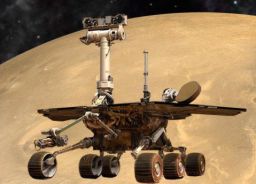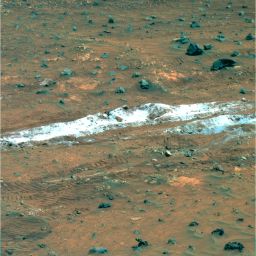A.J.S. Rayl • May 26, 2011
Mars Exploration Rovers Update: NASA Ends Spirit Mission
The intensified effort to recover Mars Exploration Rover (MER) Spirit came to an end early Wednesday morning Pacific time and NASA has now transitioned the mission to a single-rover operation focused on Spirit's still-active twin, Opportunity.
A series of final commands sent through Deep Space Network antennas electronically urged Spirit on its Martian day or Sol 2627 to respond. But when those commands were greeted with sounds of silence, NASA had already made the decision to draw the curtain on Spirit. The announcement emerged late Tuesday afternoon in a hastily arranged press teleconference.
The end of Spirit’s mission -- which took all of humankind on “the first real overland expedition across another planet,” as Steve Squyres, MER principal investigator, describes it -- has been in the scope for months.
Scuttlebutt was that there was an ever-increasing desire among some agency officials at headquarters to pull the plug, so to speak, on Spirit’s mission sooner rather than later. In recent weeks, according to inside sources, pressure was ratcheted up.
As of less than a week ago, plans called for the intensified effort -- a strategy that listened for and reached out to Spirit with commands almost every day and which was slated to end May 25, as reported in previous MER Updates -- to segue into a reduced operations effort that would continue listening and reaching out for Spirit once a week. But in a ‘poll’ Monday, the general consensus among engineers at the Jet Propulsion Laboratory (JPL), the NASA center where the Mars Exploration Rovers (MERs) were ‘born’ and are being managed, was, essentially this: hearing from Spirit again at this point was unlikely, and even if the rover did respond now, it would be unable to do much before the next Martian winter took hold, something Bill Nelson, chief of the rover engineering team, confirmed.
While there will be additional attempts to make contact with Spirit between now and the end of the year, the reduced operations have been further reduced and the intrepid little robot field geologist’s mission is now -- officially -- over.
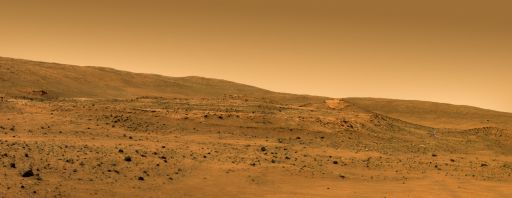 Farewell Spirit, Farewell
Farewell Spirit, FarewellSpirit, which is about the size of a golf-cart disappears on the shoulder of Home Plate in this artist's rendition showing the rover's position. This is where she became bogged down along the edge of a sand-filled crater in May 2009, in an area the team calls Troy. The panorama -- into which the rover was placed by artist Glen Nagle -- was taken by the rover on her Sol 743, while descending from Husband Hill. Home Plate is the plateau occupying the center of the image; the rover is in the valley to its right, which on Mars is to the west.Credit: NASA / JPL / Cornell / G. Nagle
Reality and “DSN resources needed for Mars Science Laboratory (MSL)” and the next-gen rover, Curiosity, led to the ending of Spirit’s mission now, according to David Lavery, NASA’s program executive for solar system exploration, during the press teleconference Tuesday.
"We always knew we would get to this point," noted John Callas, MER project manager, of JPL. "We're here today because we wore Spirit out."
The only question for most rover-informed reporters was -- why today? A televised press conference to announce the end of Spirit's mission had been planned for June 1st at NASA headquarters in Washington DC, with a number of principals from the mission, including Squyres, and NASA associate administrator Ed Weiler present, but that apparently was not to be.
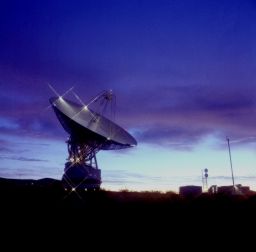 The DSN's Goldstone antenna
The DSN's Goldstone antennaThe DSN currently consists of three deep-space communications facilities placed approximately 120 degrees apart around the world: at Goldstone, in California's Mojave Desert; near Madrid, Spain; and near Canberra, Australia. This strategic placement permits constant observation of spacecraft as the Earth rotates, and helps to make the DSN the largest and most sensitive scientific telecommunications system in the world. The 70-meter antenna at Goldstone, picture here, was brought back into service in early November 2010, after eight months of maintenance that included replacing the runners.Credit: NASA
On Tuesday morning, the Associated Press (AP) posted a story on the Internet in which Alicia Chang reported the May 25 end date for the [intensified] effort and the coming end for Spirit. It was labeled as breaking news. While the May 25 end date had been known and reported, other media responded, calling JPL and requesting interviews, some thinking they’d been snookered out of an exclusive. “But we don’t give exclusives,” said Jane Platt, of JPL’s public affairs office. [In fact, that would be against NASA regulations.]
Enough media requests for interviews came in Monday and early Tuesday however, ostensibly on the heels of the AP story, that NASA headquarters officials, believing the story undermined its planned press conference, , according to sources, decided to announce early.
While the speed of communications these days has rendered everything (almost) instant these days, this was, by any objective account, last minute. Email notices that a teleconference was being held were received by reporters, in some cases, just minutes before it was to begin. Some media members were seriously disgruntled. For others outside the media, "Spirit deserved better," something more than “a slapdash, unceremonious see-ya,” as one follower put it. Whatever the plan, however it went down, Spirit's mission is over. Tuesday’s press teleconference, with Lavery and Callas, was and remains the official announcement. Finis.
Opportunity seems to be doing everything it can to make up for the loss of its twin, all but burning up the plains of Meridiani Planum on its race to the huge crater called Endeavour for what will likely be the greatest scientific find on the now 7+-year MER mission. "Opportunity has an exciting adventure ahead of it," noted Callas. "In fact, we have more science objectives today -- right now, with Opportunity -- than we did when we landed on Mars."
Even so, as NASA announced ‘lights out’ for Spirit, the science exploration spotlight lingered -- and lingers still -- on “the little rover that could,” as Ray Arvidson, MER deputy principal investigator, remembered the robot that was once his primary science charge.
Indeed, May 25, 2011 marks the end of one of the most successful planetary exploration missions ever launched as one of the greatest space stories ever told comes to a close.
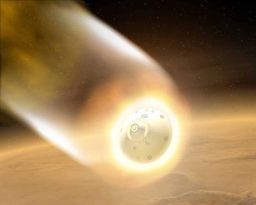 The first minute of terror
The first minute of terrorThe aeroshell, as depicted here in this artist's rendering, protected Spirit, which was folded up and cocooned inside, from the fiery temperatures as she entered the Martian atmosphere on Jan. 3, 2004, US Pacific time.Credit: NASA / JPL-Caltech
En route to Mars, the MERs were zapped by the then-largest solar flare on record, but they shook it off and pressed on. First Spirit, then three weeks later Opportunity – parachuted safely to opposite ends of the Martian southern hemisphere in January 2004.
From the beginning, landing in more rugged terrain, a little further south of the Martian equator than her twin, Spirit would always have the tougher road to hoe, literally and figuratively. Although she did garner a reputation as something of a drama queen, she was a trooper’s trooper from the beginning.
Spirit made the “six minutes of terror” coming into the Martian atmosphere look easy, and bounced, just as designed, to a landing, arriving intact, ready to rove into for what was supposed to be a three-month mission. It was then, that night, January 3, 2004, (Pacific time) that this little rover captured the hearts of people everywhere on planet Earth. Spirit had the world at first "beep," and if you didn't know better you'd think she knew it.
In six+ years of roving, Spirit drove 4.8 miles (7.73 kilometers), more than 12 times the goal set for the mission, crossing a rocky plain to reach a distant range of hills named for the Columbia space shuttle and crew. There, she became the first robot to climb a mountain, well… summit a hill the height of the Statue of Liberty, Husband Hill, named for Columbia Commander Rick Husband, a huge feat for a rover that was designed to rove not climb. And when Spirit's right front wheel became disabled in 2006, she simply turned around and roved on, backward, valiantly, defying all odds. And Mars seemed to respond.
Then, in May 2007, because of her handicap, Spirit discovered near pure silica around a circular volcanic formation called Home Plate, as she was dragging her broken wheel. It was a huge discovery in the realm of planetary sciences. “Spirit's unexpected discovery of concentrated silica deposits was one of the most important findings by either rover,” noted Squyres, of Cornell University. “It showed that there were once hot springs or steam vents at the Spirit site, which could have provided favorable conditions for microbial life.” And finding past water and conditions that may have been habitable for life is exactly what the rovers were sent to find.
 Husband Hill Summit Panorama
Husband Hill Summit PanoramaNearly a full Martian year [approximately 2 Earth years] after landing on Mars, Spirit reached the summit of Husband Hill. Spirit captured the 653 images required for this panorama between her Sols 583 and 586 (Aug. 24 to 27, 2005). This was then the largest panorama ever shot from either rover, including the entire deck of the rover. The full-size panorama spans 22,348 pixels in width and is available at the Planetary Photojournal.Credit: NASA / JPL / Cornell University
As Spirit was cruising along the western side of Home Plate, on the way to the next target destinations to the south in April 2009, the rover unknowingly drove onto the edge of a small, previously hidden, sand-filled crater and by early May, it was clear her left wheels were seriously dug in. After months of research on Earth, in November 2009 the team began sending commands to have the rover begin extricating itself.
When the first extrication strategy failed, the team switched to Plan B and in late January 2010 was beginning to make real progress. But winter brought Spirit to a stop, and the rover was forced to shelter in place, unable to move to a Sun-facing slope so that its solar panels could gather enough sunlight energy to ensure survival through the long, six-month-long Martian winter, the most brutal season Spirit would face.
Spirit’s last communiqué arrived on March 22, 2010. No one knows for sure what has happened to the rover since.
Engineers assume Spirit tripped the low power fault and went into a hibernation mode to rest and try to collect enough photon energy to keep its survival heaters available and keep the mission clock running. That is what it was programmed to do.
Some months ago, the rover engineers also began to suspect it may have gotten so cold at Gusev Crater that the mission clock may also have faulted. Certainly, Spirit experienced colder internal temperatures last year than in any of the previous Martian winters. With inadequate energy to run its survival heaters, the temperature of the rover's electronics may have dropped, actually, to an estimated -65 degrees Fahrenheit (-54 Celsius), below the “warrantied” temperature for many components and parts.
The extreme cold could have easily damaged any one or number of critical components and wires on the robot. Or it could be that Spirit has simply acquired so much dust on its solar panels that it is blocking sunlight needed to produce required power. That -- the dust -- was what many expected would ultimately take these robot field geologists out.
For a little more than a year now, engineers have tried repeatedly to get Spirit’s computer to respond to signals. They have listened and sent command signals hoping to "nudge" the rover to respond. In recent weeks, during the intensified efforts, those sessions have been ongoing almost every day. But Spirit has not responded.
The radio scientists working with NASA’s DSN will from time to time, as schedules permit, listen and command now and again, just on the off chance. “While we no longer believe there is a realistic probability of hearing from Spirit, the Deep Space Network may occasionally listen for any faint signals when the schedule permits," confirmed Lavery.
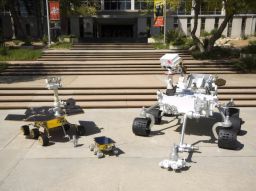 Rover family portrait
Rover family portraitFull-scale models of three generations of Mars rovers: Sojourner (center), which landed with Mars Pathfinder on July 4, 1997; the Mars Exploration Rovers Spirit and Opportunity (left), which landed on Mars on Jan. 3 and 24, 2004; and Mars Science Laboratory (MSL) Curiosity, set to launch for Mars in November or December 2011. Credit: NASA / JPL
The communications assets used by Spirit, including the DSN, plus two NASA Mars orbiters -- Mars Odyssey and the Mars Reconnaissance Orbiter -- that can relay communications, are now needed to prepare for NASA’s MSL mission, he said. “We’re now transitioning assets to support the November launch of our next generation Mars rover, Curiosity," said Lavery. "We're all taking a realistic look at the situation,” he added in summation during the teleconference.
"Our job was to wear these rovers out exploring, to leave no unutilized capability on the surface of Mars, and for Spirit,” Callas pointed out. “We have done that.”
Real life alien drama, entertainment, courage, heroism, jaw-dropping discoveries and a reason to be proud -- they're all a part of the Spirit story. "What's most remarkable to me about Spirit's mission is just how extensive her accomplishments became," said Squyres. " Spirit explored just as we would have, seeing a distant hill, climbing it, and showing us the vista from the summit. And she did it in a way that allowed everyone on Earth to be part of the adventure."
A robot to the outside world, Spirit was -- and always will be -- a team member to the Mars Exploration Rover crew, a team member to which they have become varyingly attached. Thus, the mood among team members right now is mixed. "There is sadness," Callas said earlier today.
Although Mars Pathfinder/Sojourner paved the rover way, Spirit and Opportunity went over Martian hill and dale, lived long and prospered. No one expected either rover to survive the first Martian winter much less the first deadly, planet circling dust storm, but they did, and then just kept going and going and going. Together, the rovers have gone so far above and beyond the call of expectation and duty it's uncanny.
“We have invested a lot of our emotions into these rovers," said Callas, who 'nursed' the girls, as they are affectionately known around JPL, back when they were in a stage of incubating creation. The analogy he has used on numerous previous occasions is that this loss is “like losing a loved one.”
And Spirit is loved the world over.
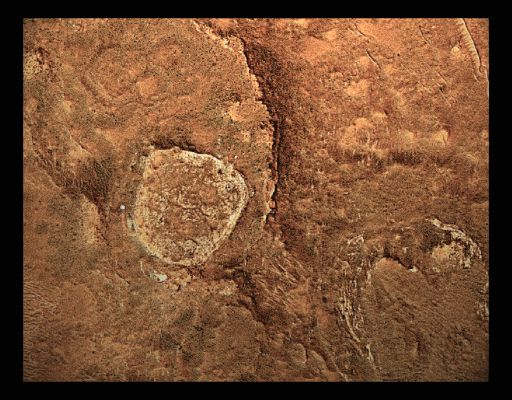 Sleep well, Spirit
Sleep well, SpiritIn this image taken on Mar. 31, 2011 by the HiRISE camera onboard the Mars Reconnaissance Orbiter and colorized and turned into art by Stuart Atkinson, Spirit seems to shine in the Sun. It's a fitting, final salute from a star of space and screen. [Spirit is the tiny white spot to the left of the circular formation in the left portion of the image.]Credit: NASA / JPL-Caltech / UA / colorized by S. Atkinson
The emotions in Roverville are as thick as the dust in the middle of a ‘devil’ on Mars in summer -- and they aren't likely to settle soon. A world without Spirit is going to take some adjustment, and reality, for many, has yet to set in.
There are "near tears" in the hallways of JPL -- and yet, at the same time, there is a sense of real acheivement, said Callas.
“I thought I would be feeling really sad now,” offered Scott Maxwell, lead rover driver yesterday. “But right now, I’m really feeling more a sense of -- pride. Next week when I come in for work though and this reality settles in,” he added, “I’m not sure how I’ll be feeling.”
The May MER Update will feature a more detailed look back on Spirit’s mission, and will be posted here, as usual, on the last day of the month.
Support our core enterprises
Your support powers our mission to explore worlds, find life, and defend Earth. You make all the difference when you make a gift. Give today!
Donate

 Explore Worlds
Explore Worlds Find Life
Find Life Defend Earth
Defend Earth


